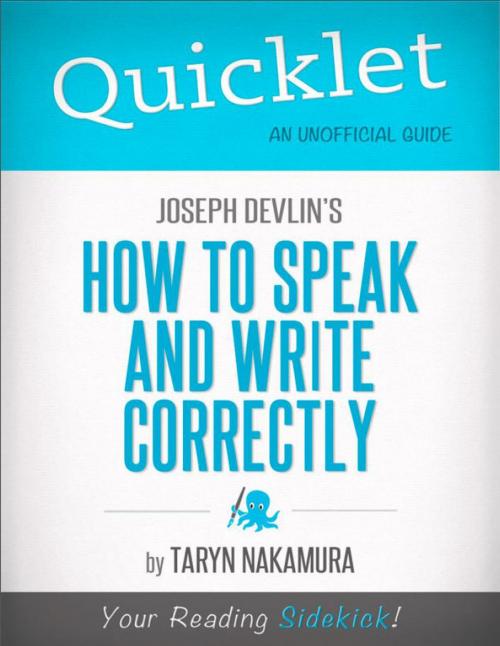Quicklet on Joseph Devlin's How to Speak and Write Correctly
Fiction & Literature, Literary Theory & Criticism, Nonfiction, Reference & Language, Reference| Author: | Taryn Nakamura | ISBN: | 9781614649199 |
| Publisher: | Hyperink | Publication: | February 24, 2012 |
| Imprint: | Hyperink | Language: | English |
| Author: | Taryn Nakamura |
| ISBN: | 9781614649199 |
| Publisher: | Hyperink |
| Publication: | February 24, 2012 |
| Imprint: | Hyperink |
| Language: | English |
ABOUT THE BOOK
In the introduction to How to Speak and Write Correctly, Joseph Devlin writes that his book is not a grammar manual full of rules. Devlin wrote the book for ordinary people who want to speak in a proper manner.
Devlin writes some general guidelines for grammar and style. He begins with an overview of the parts of speech and formation of sentences and paragraphs. Some of his most helpful tips are those on common pitfalls. He reminds the reader that even the best writers make mistakes. Using examples of famous authors’ mistakes, Devlin shows how to avoid circumlocution, split infinitives, and redundancy.
The chapters on writing letters and writing for newspapers have obsolete information. However, these chapters serve as amusing artifacts of the days when calling cards were still common, and women were guardians of the home.
MEET THE AUTHOR
Taryn Nakamura was born and raised in Hawaii, where she's recently returned after receiving a B.A. in English at Yale University. As a writing concentrator at Yale, she focused on fiction, but as a Hyperink writer, she's learned that nonfiction can also be fun. In her free time, she likes to run at a walking pace, haunt libraries, and eat pickles.
EXCERPT FROM THE BOOK
In the simplest sentence, the word order is subject, verb, object. Longer sentences allow for other ways of arranging words.
The beginning and the end of sentences are the most important positions. The reader pays closer attention to these parts of the sentence. The end of the sentence is more significant than the beginning. Do not begin or end a sentence with insignificant words.
Loose sentences put the main idea first, and the descriptions follow. Periodic sentences begin with descriptive introductions and ends with the main idea. Speakers should use loose sentences to keep an audience’s attention. Either form can be used in writing.
A paragraph should be composed of sentences that illustrate the same idea. Sentences should flow naturally with transitions. The content should show a logical progression. The first sentence introduces the main idea, and the last sentence enforces it...
Buy a copy to keep reading!
ABOUT THE BOOK
In the introduction to How to Speak and Write Correctly, Joseph Devlin writes that his book is not a grammar manual full of rules. Devlin wrote the book for ordinary people who want to speak in a proper manner.
Devlin writes some general guidelines for grammar and style. He begins with an overview of the parts of speech and formation of sentences and paragraphs. Some of his most helpful tips are those on common pitfalls. He reminds the reader that even the best writers make mistakes. Using examples of famous authors’ mistakes, Devlin shows how to avoid circumlocution, split infinitives, and redundancy.
The chapters on writing letters and writing for newspapers have obsolete information. However, these chapters serve as amusing artifacts of the days when calling cards were still common, and women were guardians of the home.
MEET THE AUTHOR
Taryn Nakamura was born and raised in Hawaii, where she's recently returned after receiving a B.A. in English at Yale University. As a writing concentrator at Yale, she focused on fiction, but as a Hyperink writer, she's learned that nonfiction can also be fun. In her free time, she likes to run at a walking pace, haunt libraries, and eat pickles.
EXCERPT FROM THE BOOK
In the simplest sentence, the word order is subject, verb, object. Longer sentences allow for other ways of arranging words.
The beginning and the end of sentences are the most important positions. The reader pays closer attention to these parts of the sentence. The end of the sentence is more significant than the beginning. Do not begin or end a sentence with insignificant words.
Loose sentences put the main idea first, and the descriptions follow. Periodic sentences begin with descriptive introductions and ends with the main idea. Speakers should use loose sentences to keep an audience’s attention. Either form can be used in writing.
A paragraph should be composed of sentences that illustrate the same idea. Sentences should flow naturally with transitions. The content should show a logical progression. The first sentence introduces the main idea, and the last sentence enforces it...
Buy a copy to keep reading!















